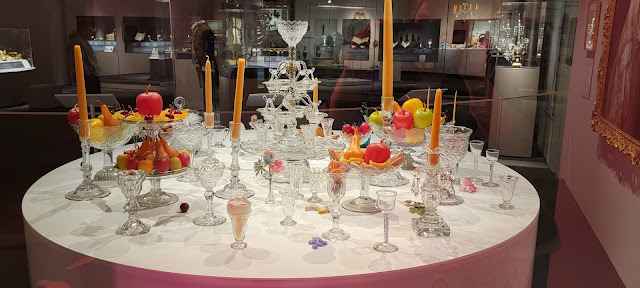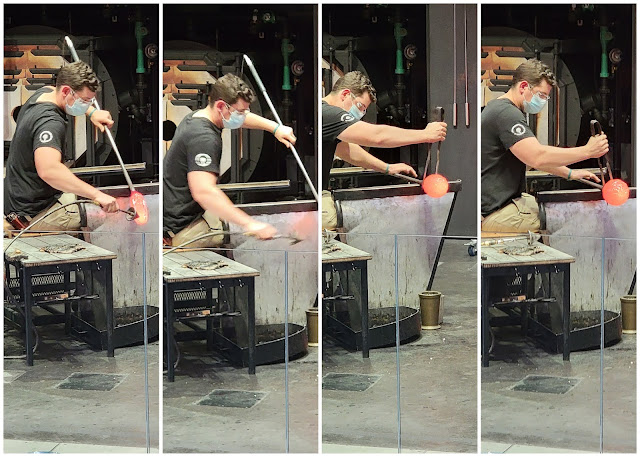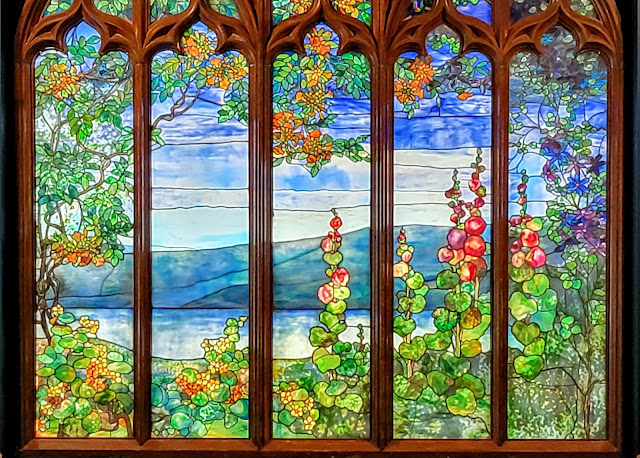 |
| Still Life with Two Plums, 2000, Flora Mace and Joey Kirkpatrick |
The Corning Museum of Glass should be on your bucket list, if it’s not already.
This museum, located not coincidentally, in Corning NY, is dedicated to the art, history and science of glass.
 |
| Endeavor, 2004, Lino Tagliapietra, blown, hot-worked glass, cut, battuto cut; steel cable. |
Corning was a household word: “go get the little square corning,” my mother would say as I was helping in the kitchen. She had a storage drawer filled with corningware, a go to for her.
I grew up with corningware Spice of Life and Cornflower patterns, and in fact, I still have a cupboard filled with various shapes and sizes of the French White collection, received as wedding and birthday gifts and treasured members of my kitchen, and not just because of nostalgia.
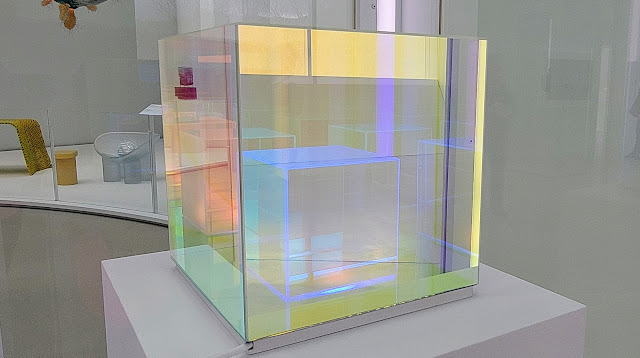 |
| Fresnel Cube Table Lamp, designed 2015, made in 2017, Sean Augustine March, optical-grade dichroic borosilicate plate glass, 5-watt LED bulb, silicone, cord, electronic components, wood. |
My treasure trove of corningware has lasted me more than 2 decades. I bake my Thanksgiving and holiday pumpkin pies in them, bake my lasagnas and mac and cheese casseroles in them, cook my pot roasts in them. I store leftovers and bring my lunches in them. My first set of dishes was Corelle, a practically unbreakable set of dishware.
But the Corning Museum of Glass is more than about corningware and Corelle and the like, although it details the development of glass and its use in industry and how glass contributed to such diverse aspects of our civilization, from food cooking and preservation to communication and transportation to the evolution of lighthouse light lens.
 |
| Forest Glass, 2009, Katherine Gray, glass, acrylic, steel; about 2000 found machine-made drinking glasses. |
Some of the more than 50 thousand glass objects in the museums collection are more than 3500 years old — mind boggling, if you think about it.
 |
| The Secret Life of Glass, Spencer Finch, made in United States (Portland, OR and Brooklyn and Corning, NY), fused glass and aluminum. |
The museum explores the art of glass as well as its industrial uses: the collection of contemporary artworks includes pieces by significant artists such as Klaus Moje, Karen LaMonte, Bruno Pedrosa, Dale Chihuly, Libenský / Brychtová, Ginny Ruffner and Josiah McElheny.
 |
| Fern Green Tower, 1999 and reconfigured in 2013 (upon the artist’s request), Dale Chihuly, blown glass, steel structure. |
Okay, so only one of those names I was familiar with — I first encountered the genius of Chihuly, of all places, at the Phipps Conservatory, but I quickly fell in love with his Medusa-like sculptures.
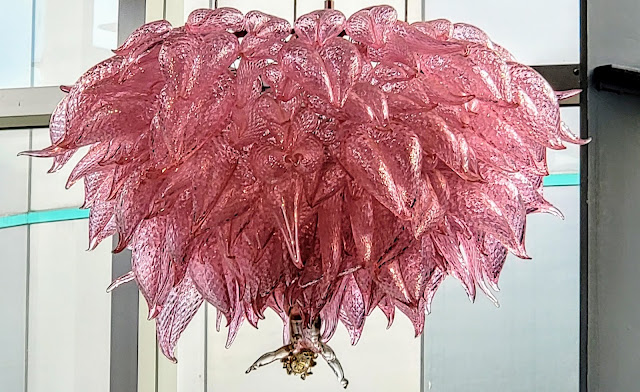 |
| Erbium Chandelier, 1993, Dale Chihuly with the help of Lino Tagliapietra, mold-blown, blown, and hotworked glass and gold leaf. |
I absolutely loved some of the quirkier sculpture.
 |
| Self-Portrait (Clown), 1997, Michael Lucero, Found and blown glass, assembled. |
Even the glass tire was beautiful.
 |
| Tire, designed in 1995-1996, created in 2005, Robert Rauschenberg with the help of Daniel Spitzer and Dan Dailey, mold-blown glass, cold worked; silver-plated steel tire carrier. |
The Glass Collection Galleries explore Near Eastern, Asian, European, and American glass and glassmaking from antiquity through present day.
The galleries contain objects representing every country and historical period in which glassmaking has been practiced.
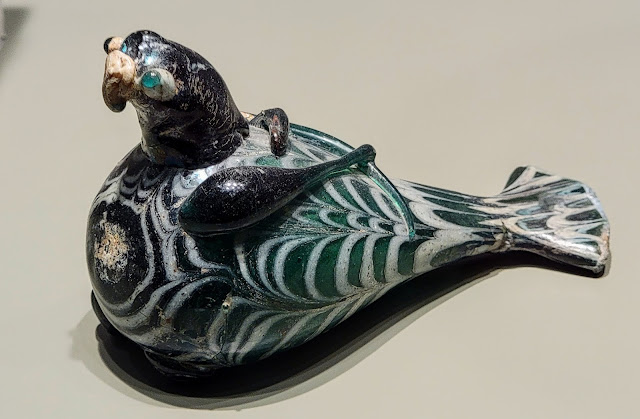 |
| Bird, about 1200-1299 CE, blown, applied, marvered, dragged and blobbed glass. |
My favorite part of the museum was the contemporary glass gallery, a gallery bathed in white, with daylight flooding in through airy glass windows: I felt as if the gallery rooms themselves were part of the art.
The galleries include: Glass in Nature, Origins of Glassmaking, Glass of the Romans, Glass in the Islamic World, Early Northern European Glass, The Rise of Venetian Glassmaking, Glass in 17th-19th Century Europe, 19th Century European Glass, Asian Glass, Glass in America, Corning: From Farm Town to “Crystal City,” Paperweights of the World and Modern Glass.
 |
| Bracelet with decoration, made in China between 1800 and 1911, cast, cased and carved glass. |
In addition to these galleries, there is the Jerome and Lucille Strauss Study Gallery, Frederick Carder Gallery, Ben W. Heineman Sr. Gallery of Contemporary Glass, and the Contemporary Glass Gallery. The Study Gallery is filled with a wide range of objects from all periods.
 |
| Fish, probably made in the Eastern Mediterranean between 1 and 99 CE, blown and applied glass. |
As you walk through the various galleries and museum spaces, you’ll gain a good sense of the importance of glass to our civilization and how various cultures have adapted and shaped its use.
And of course, while you’re visiting the museum, you’ll want to take advantage of the free glass-blowing and glass-firing demonstrations: the two we watched were fascinating.
We spent about two hours at the museum, and that was probably rushing it — allow yourself three hours to explore the galleries, watch the various demonstrations, and learn the history of glass-making.
 |
| Murano glass chandelier. |
Getting there: 1 Museum Way, Corning, NY
Hours: 9 a.m. – 5 p.m., daily, Labor Day through Memorial Day, 9 a.m. – 7 p.m., daily, Memorial Day through Labor Day
Website: https://home.cmog.org/
 |
| Megaplanet, 2006, Josh Simpson, fused murrine, furnace worked, applied cane drawing, applied decoration, applied gold and silver foils. |
Check out other fun things to do in the Finger Lakes region:
- Corning in the Morning
- Fort Hill Cemetery — COMING SOON!
- Harriet Tubman House
- Rockwell Museum
- Watkins Glen Waterfalls — COMING SOON!
- William Seward House — COMING SOON!
- Women’s Rights National Park


